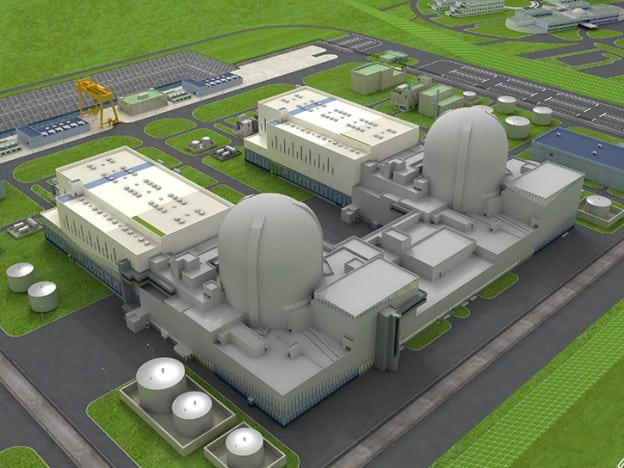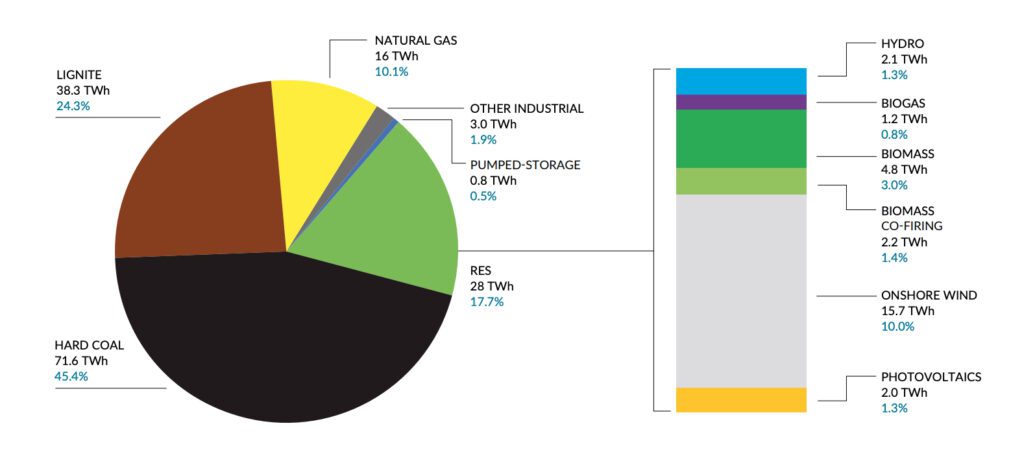Potential Deal Brewing for Second Polish Nuclear Plant Based on South Korean Technology
Credit to Author: Sonal Patel| Date: Wed, 02 Nov 2022 14:38:56 +0000

Days after Poland chose Westinghouse to supply its AP1000 technology to the country’s first nuclear plant in Pomerania, northern Poland, the government and two Polish energy firms signed a letter of intent with Korea Hydro & Nuclear Power (KHNP) to “push ahead” with development of a second nuclear plant based on APR1400 technology in Pątnów, central Poland.
ZE PAK, one of Poland’s largest private energy groups, and PGE Polska Grupa Energetyczna (PGE), a massive integrated energy firm majority-owned by Poland’s government, and KHNP on Oct. 31 said they would jointly assess cooperative opportunities on the construction of the Pątnów plant.
“The project is intended to support the independence and stability of the Polish energy system—simply to be a stable source of cheap and clean energy,” the companies said in a joint statement on Monday. “Ultimately, the project should increase the competitiveness of the Polish economy, create new investment opportunities in Poland, but above all, provide Polish households with cheap and clean energy at a stable price for the next 60 years.”
Poland’s Urgency to Build New Nuclear
The letter of intent follows a much-watched international contest between some of the world’s most prominent large nuclear plant vendors for the opportunity to build Poland’s nuclear power fleet.
The Eastern European country holds the largest reserves of coal in Europe, and in 2020, it produced 70% of its power from coal. However, the country’s Council of Ministers in February 2021 adopted an energy policy that will dictate how the country will carry out its energy transformation through 2040 to meet stringent European Union (EU) climate neutrality goals by 2050, while boosting its own energy and economic security, and retain a stable labor market.

The country’s energy policy envisions a phase-out of its coal plants by 2040. It plans to replace that capacity with 11 GW of new renewable capacity. As POWER has reported in detail, pivotal to Poland’s plans is the construction of about 6 GW to 9 GW of large-scale, pressurized water Gen III and III+ nuclear reactor designs, “zero-emission sources” that the government projects could “account for half of the installed capacity in 2040.”
The February 2021 energy policy calls for its first nuclear power reactor to begin construction in 2026 and be completed by 2033. The initial unit will be followed by five more units, which are planned to be commissioned at intervals of two to three years, timeframes that are designed to support “the power balance” in the national power system. The plan designates an investment of PLN 140 billion (about $40 billion) for the new builds.
The task is substantial, Poland’s government has acknowledged. While the country implemented a nuclear power program in the 1980s, it abandoned construction of its first two nuclear plants, Żarnowiec and Warta, in 1990. Re-establishing a nuclear power program will require developing the necessary infrastructure, including legal, organizational, institutional, scientific and research, and personnel training systems that will support nuclear plant operation.
Acting with urgency, the country first set out to explore models for financing its massive investment in nuclear. In May 2021, it unveiled the “SaHo” model, in which the state spearheads investment at the initial stage—taking over most of the high investment risk and high costs of capital at the investment stage—and then selling shares in the plant before grid connection to reduce its financial involvement in the long term. Then, in July 2021, Poland established Polskie Elektrownie Jądrowe (PEJ)—an entity whose shares are currently 100% held by the state treasury—that it tasked with development of the investment process, site investigation, and obtaining permits and licenses for the country’s first nuclear power plant.
Poland also designated preferred sites, first at the coast (Lubiatowo-Kopalino and Żarnowiec), to ensure adequate cooling water and grid interconnection, and then in central Poland (around Bełchatów or Pątnów). In December 2021, PEJ identified its preferred site, Lubiatowo-Kopalino, in the Choczewo coastal commune. PEJ said the site met all environmental requirements from surveys conducted since 2017. In March 2022, PEJ then submitted an environmental impact assessment report to the General Director for Environmental Protection, and in September, it applied to the National Atomic Energy Agency to verify the scope of safety analyses for its proposed plants.
A Fierce International Contest
Meanwhile, the country has assessed Generation III technologies that could make up its initial plants. While France’s EDF in October 2021 offered to build six 1.7-GW EPR units, KHNP in April 2022 offered to build six 1.3-GW APR1400 units, along with a prospect to finance 20% to 30% of the project. Poland also signed an intergovernmental agreement with the U.S. to explore as much as 9 GW of installed nuclear capacity. Forerunners bolstered by U.S. diplomacy included Westinghouse and Bechtel, which teamed to supply AP1000 technology.
On Oct. 28, Prime Minister Mateusz Morawiecki announced the Pomerania project would use AP1000 technology. A Council of Ministers resolution and a formal agreement with Westinghouse is expected on Nov. 2.
A strong
–
alliance guarantees the success of our joint initiatives. After talks with @VP K.Harris and @SecGranholm we confirm our nuclear energy project will use the reliable, safe technology of @WECNuclear. Thank you @USAmbPoland. Council of Ministers resolution on Wednesday
— Mateusz Morawiecki (@MorawieckiM) October 28, 2022
The competition was fierce. Polish and South Korean media circulated figures suggesting that KHNP’s bid was the lowest of all competitors. “Reportedly, KHNP offered to build all six reactors for $26.7 billion compared to Westinghouse’s $31.3 billion and EDF’s $33 billion,” said Korea JoongAng Daily.
However, backed by U.S. diplomacy, Westinghouse made substantial ground in September, signing memoranda of understanding (MOUs) with 22 Polish companies that allowed for the potential cooperation of AP1000 reactors in the first Polish plant and other potential plants in Central Europe. Westinghouse notably also filed a legal complaint at the U.S. District Court for the District of Columbia on Oct. 21 seeking injunctive relief against KHNP after it learned that Korea Electric Power Corp. (KEPCO) was poised to enter into a memorandum of intent (MOI) with the Polish government to deliver APR1400 nuclear plants.
The APR1400, a two-loop, evolutionary pressurized water reactor (PWR) design, evolved from the OPR1000 Korean Standard Nuclear Power Plant design and Combustion Engineering’s (now Westinghouse’s) System 80+ design. While it was developed for use in South Korea, KHNP in 2010 sold four APR1400 reactors to the United Arab Emirates, three of which are already connected to the grid. KHNP in August also won a $2.5 billion order to build four units of Egypt’s first nuclear power plant.
In its complaint last week, Westinghouse underscored that KEPCO’s Advanced Power Reactor (APR) and its variants (APR1000, APR1400, and OPR1000) are “derived from, based on, and incorporates technology” licensed to KEPCO and KHNP by Westinghouse’s “predecessor-in-interest” Combustion Engineering. Westinghouse asserted that KHNP’s delivery of technical information regarding South Korean reactor designs outside South Korea constitutes a “retransfer of the technology” licensed to the South Korean entities. It asked the court to rule that the APR1400 is subject to review by the U.S. Department of Energy under Part 810 of Title 10 under the Code of Federal Regulations, which implements provisions of the Atomic Energy Act. “Although Poland does not require specific authorization under Part 810, Westinghouse—as the U.S. exporter and licensor of the Licensed Technology that would be retransferred to Poland as incorporated in APR1400—still must comply with Part 810 reporting requirements,” the company alleged.
KHNP Continues Efforts to Secure Nuclear Deal in Poland
KHNP’s letter of intent signed on Monday with ZE PAK and PGE, however, suggests APR1400 reactors may still be built in Poland. ZE PAK and PGE said one reason they chose the technology is that KHNP—the third-largest nuclear power plants operator in the world—“recently successfully completed one of the world’s largest investments on time and on budget—the nuclear power plant in the United Arab Emirates in Barakah.” Along with the Barakah units, KHNP has 24 units of nuclear power plants in operation and two under construction in South Korea, they noted.
South Korea’s Minister of Trade, Industry, and Energy Chang-Yang Lee on Monday highlighted the potential deal’s significance. “First, the project is evaluated as an achievement supported by the Korean government’s firm determination and policy to export nuclear plants. For Korea, the project has reopened the gate for nuclear power plant exports in 13 years since the export to the UAE in 2009 while it validates the excellence of the APR1400,” he said.
“Also, once the final contract is made, we anticipate that it will greatly contribute to revitalizing the domestic nuclear industry by providing the nuclear industry struggling with lack of business with work. Moreover, the project will be an opportunity for the level and depth of cooperation in the industrial and economic sectors between our two countries to be broadened. Amidst the recent instabilities in the global supply chain network, we plan on expanding this cooperation in nuclear power to various areas such as the defense industry, batteries, hydrogen and electric vehicles,” Lee added.
ZE PAK, PGE, and KHNP now plan to perform a preliminary analysis of the geotechnical, seismic and environmental conditions. They will also develop an estimated budget for the preparatory work, construction phase, and production phase, along with a proposed project financing model. In addition, they plan to create “a variant project implementation schedule” along with the definition of key stages affecting the potential project implementation.
If all is completed satisfactorily, the parties will prepare a preliminary development plan for the Pątnów nuclear power plant by the end of 2022, and possibly sign a definitive contract a year later. Thereafter, construction could begin in 2025 or 2026, South Korea’s Trade Ministry suggested on Monday.
South Korean media, however, noted concerns pervade about Westinghouse’s intellectual property suit. Trade Minister While Lee on Monday told reporters that he is confident the KHNP deal with the Polish energy companies will be sealed, he believes that “KHNP and Westinghouse will be able to resolve their differences and work together,” reported news agency Pulse.
—Sonal Patel is a POWER senior associate editor (@sonalcpatel, @POWERmagazine).
The post Potential Deal Brewing for Second Polish Nuclear Plant Based on South Korean Technology appeared first on POWER Magazine.
 –
– alliance guarantees the success of our joint initiatives. After talks with
alliance guarantees the success of our joint initiatives. After talks with